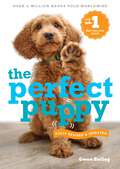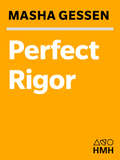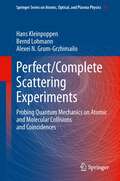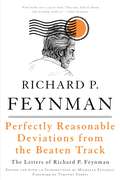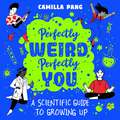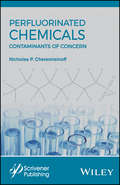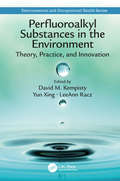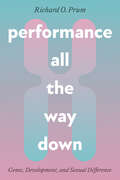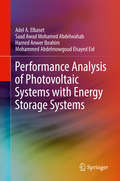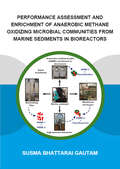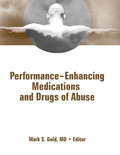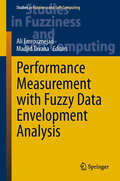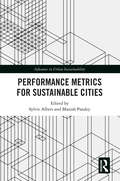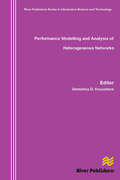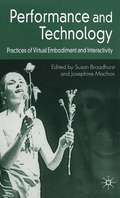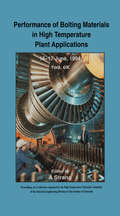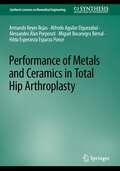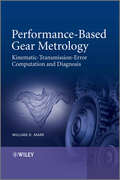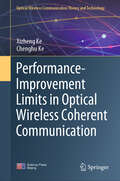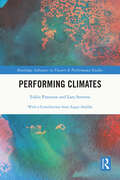- Table View
- List View
Perfect Puppy: The classic puppy training book now fully revised and updated
by Gwen BaileyTHE NO.1 BEST-SELLING GUIDE - OVER 1/2 MILLION BOOKS SOLD WORLDWIDEGwen Bailey's ORIGINAL puppy training guide is back - FULLY REVISED and UPDATED for 2024!Packed with the most up-to-date findings in canine behaviour and sporting a brand-new, user-friendly design, this stunning edition will teach how to raise a problem-free dog. From housetraining to games and shared activities, learn how to teach your dog good manners and build their confidence in the world around them. Complete with step-by-step training and socialisation plans, as well as no-nonsense guides to understanding and preventing biting, chewing, aggression, and other problems.* BRAND NEW content and UPDATES throughout.* FRESH photography, that brings every lesson to life.* The LATEST methods and practices, to stay ahead in the ever-evolving world of dog training.* SUPER CLEAR, and USER-FRIENDLY layout.* Over half a million copies sold worldwide!Join hundreds of thousands of owners across the world who have already transformed their puppies into healthy, happy and obedient companions.
Perfect Puppy: The classic puppy training book now fully revised and updated
by Gwen BaileyTHE NO.1 BEST-SELLING GUIDE - OVER 1/2 MILLION BOOKS SOLD WORLDWIDEGwen Bailey's ORIGINAL puppy training guide is back - FULLY REVISED and UPDATED for 2024!Packed with the most up-to-date findings in canine behaviour and sporting a brand-new, user-friendly design, this stunning edition will teach how to raise a problem-free dog. From housetraining to games and shared activities, learn how to teach your dog good manners and build their confidence in the world around them. Complete with step-by-step training and socialisation plans, as well as no-nonsense guides to understanding and preventing biting, chewing, aggression, and other problems.* BRAND NEW content and UPDATES throughout.* FRESH photography, that brings every lesson to life.* The LATEST methods and practices, to stay ahead in the ever-evolving world of dog training.* SUPER CLEAR, and USER-FRIENDLY layout.* Over half a million copies sold worldwide!Join hundreds of thousands of owners across the world who have already transformed their puppies into healthy, happy and obedient companions.
Perfect Rigor: A Genius and the Mathematical Breakthrough of the Century
by Masha GessenA gripping and tragic tale that sheds rare light on the unique burden of genius In 2006, an eccentric Russian mathematician named Grigori Perelman solved the Poincare Conjecture, an extremely complex topological problem that had eluded the best minds for over a century. A prize of one million dollars was offered to anyone who could unravel it, but Perelman declined the winnings, and in doing so inspired journalist Masha Gessen to tell his story. Drawing on interviews with Perelman's teachers, classmates, coaches, teammates, and colleagues in Russia and the United States--and informed by her own background as a math whiz raised in Russia--Gessen uncovered a mind of unrivaled computational power, one that enabled Perelman to pursue mathematical concepts to their logical (sometimes distant) end. But she also discovered that this very strength turned out to be Perelman's undoing and the reason for his withdrawal, first from the world of mathematics and then, increasingly, from the world in general.
Perfect/Complete Scattering Experiments
by Hans Kleinpoppen Bernd Lohmann Alexei N. Grum-GrzhimailoThe main goal of this book is to elucidate what kind of experiment must be performed in order to determine the full set of independent parameters which can be extracted and calculated from theory, where electrons, photons, atoms, ions, molecules, or molecular ions may serve as the interacting constituents of matter. The feasibility of such perfect' and-or `complete' experiments, providing the complete quantum mechanical knowledge of the process, is associated with the enormous potential of modern research techniques, both, in experiment and theory. It is even difficult to overestimate the role of theory in setting of the complete experiment, starting with the fact that an experiment can be complete only within a certain theoretical framework, and ending with the direct prescription of what, and in what conditions should be measured to make the experiment `complete'. The language of the related theory is the language of quantum mechanical amplitudes and their relative phases. This book captures the spirit of research in the direction of the complete experiment in atomic and molecular physics, considering some of the basic quantum processes: scattering, Auger decay and photo-ionization. It includes a description of the experimental methods used to realize, step by step, the complete experiment up to the level of the amplitudes and phases. The corresponding arsenal includes, beyond determining the total cross section, the observation of angle and spin resolved quantities, photon polarization and correlation parameters, measurements applying coincidence techniques, preparing initially polarized targets, and even more sophisticated methods. The `complete' experiment is, until today, hardly to perform. Therefore, much attention is paid to the results of state-of-the-art experiments providing detailed information on the process, and their comparison to the related theoretical approaches, just to mention relativistic multi-configurational Dirac-Fock, convergent close-coupling, Breit-Pauli R-matrix, or relativistic distorted wave approaches, as well as Green's operator methods. This book has been written in honor of Herbert Walther and his major contribution to the field but even to stimulate advanced Bachelor and Master students by demonstrating that obviously nowadays atomic and molecular scattering physics yields and gives a much exciting appreciation for further advancing the field.
Perfectly Reasonable Deviations From the Beaten Track: The Letters of Richard P. Feynman
by Richard P. FeynmanA Nobel Prize-winning physicist, a loving husband and father, an enthusiastic teacher, a surprisingly accomplished bongo player, and a genius of the highest caliber---Richard P. Feynman was all these and more. Perfectly Reasonable Deviations From the Beaten Track--collecting over forty years' worth of Feynman's letters--offers an unprecedented look at the writer and thinker whose scientific mind and lust for life made him a legend in his own time. Containing missives to and from such scientific luminaries as Victor Weisskopf, Stephen Wolfram, James Watson, and Edward Teller, as well as a remarkable selection of letters to and from fans, students, family, and people from around the world eager for Feynman's advice and counsel, Perfectly Reasonable Deviations From the Beaten Track not only illuminates the personal relationships that underwrote the key developments in modern science, but also forms the most intimate look at Feynman yet available. Feynman was a man many felt close to but few really knew, and this collection reveals the full wisdom and private passion of a personality that captivated everyone it touched. Perfectly Reasonable Deviations From the Beaten Track is an eloquent testimony to the virtue of approaching the world with an inquiring eye; it demonstrates the full extent of the Feynman legacy like never before. Edited and with additional commentary by his daughter Michelle, it's a must-read for Feynman fans everywhere, and for anyone seeking to better understand one of the towering figures--and defining personalities--of the twentieth century.
Perfectly Weird, Perfectly You: A Scientific Guide to Growing Up
by Camilla PangUSE SCIENCE AS YOUR GUIDEBOOK FOR GROWING UP PERFECTLY WEIRD, AND PERFECTLY YOU.Growing up, Dr Camilla Pang loved patterns and ordering things. She was obsessed with Disney, infatuated by Stephen Hawking and the language she only really understood was science. Diagnosed with autism age 8, Camilla felt like an outsider - and kids often like nothing better than to gang up on outsiders.This is the story of how Camilla used science as her sidekick for navigating the world- allowing her to translate ideas she could understand (like gravity and light waves) onto things she couldn't (like people, how long to smile for, and when someone needed a hug).Now she is sharing her scientific survival guide with you - so you can grow up with the courage to be yourself, no matter how different you feel or how hard you might find it to connect. Because the hard bit of growing up isn't other people - their opinions, their friendship groups, their popularity, their exam results. No, the hard bit is you: learning who you are as a person, having confidence in your own instincts, and understanding what actually makes you happy. And the really hard part is accepting that it's completely normal to be perfectly weird.(P) 2022 Hodder & Stoughton Limited
Perfluorinated Chemicals: Contaminants of Concern
by Nicholas P. CheremisinoffThis new volume provides a timely study on the environmental challenges from a specific class of perfluorinated chemical compounds (PFCs) that are now being recognized as a worldwide health threat. Recent studies report that levels of classes of PFCs known as polyfluoroalkyl and perfluoroalkyl (PFASs) exceed federally recommended safety levels in public drinking-water supplies for 6 million people in the United States and that as many as 100 million people could be at risk from exposure to these chemicals. These chemicals occur globally in wildlife and humans. Both PFCAs and PFSAs have been produced for more than 50 years, but have only become of interest to regulators and environmentalists since the late 1990s. Recent advances in analytical methodology has enabled widespread detection in the environment and humans at trace levels. These toxic chemicals have been found in outdoor and indoor air, surface and drinking water, house dust, animal tissue, human blood serum, and human breast milk. Of great concern to communities is the presence of these compounds in a number of drinking water supplies in the U.S. and other countries. This new volume provides a timely explanation of the chemicals, provides a detailed review of the regulations both in the US and European Community, explains the health risk literature, and then explores in great detail available treatment technologies. The volume is a must for public water supply facilities, industrial operations that have historically used these chemicals and face legacy pollution issues, policy makers and the general public.
Perfluoroalkyl Substances in the Environment: Theory, Practice, and Innovation (Environmental and Occupational Health Series)
by David M. Kempisty Yun Xing LeeAnn RaczPer- and polyfluorinated alkyl substances (PFAS), often referred to as per- (and poly) fluorinated compounds (PFCs), have been used for years in many everyday¾ and some lifesaving¾ products. However, their use has been linked to adverse health effects in humans, a problem compounded by their persistence in the environment. This book discusses the various challenges of PFAS in our environment today, including their historical use as well as their chemical and toxicological properties. It also presents robust discussion of analytical challenges and special considerations in sampling. The work goes on to give practical recommendations for dealing with these compounds in today's dynamic regulatory landscape and includes several chapters on various remediation techniques. Key Features: Comprehensive overview of per- and polyfluorinated alkyl substances (PFAS) historical use and chemical/physical properties which help us understand their persistence, transport, and transformation pathways in the environment In-depth analysis of PFAS toxicology Detailed descriptions of conventional and state-of-the-art remediation technologies Practical recommendations for dealing with PFAS in a dynamic regulatory landscape Robust discussion of important sampling and analytical considerations Perfluoroalkyl Substances in the Environment: Theory, Practice, and Innovation explores the challenges across the topical areas of regulation and management, toxicology, environmental remediation, and analytical sampling and analysis.Readers will find this text helpful in understanding complexities associated with PFAS and informing management strategies to effectively protect this and future generations.
Performance All the Way Down: Genes, Development, and Sexual Difference (science.culture)
by Richard O. PrumAn award-winning biologist and writer applies queer feminist theory to developmental genetics, arguing that individuals are not essentially male or female. The idea that gender is a performance—a tenet of queer feminist theory since the nineties—has spread from college classrooms to popular culture. This transformative concept has sparked reappraisals of social expectations as well as debate over not just gender, but sex: what it is, what it means, and how we know it. Most scientific and biomedical research over the past seventy years has assumed and reinforced a binary concept of biological sex, though some scientists point out that male and female are just two outcomes in a world rich in sexual diversity. In Performance All the Way Down, MacArthur Fellow and Pulitzer Prize finalist Richard O. Prum brings feminist thought into conversation with biology, arguing that the sexual binary is not essential to human genes, chromosomes, or embryos. Our genomes are not blueprints, algorithms, or recipes for the physical representation of our individual sexual essences or fates. In accessible language, Prum shows that when we look closely at the science, we see that gene expression is a material action in the world, a performance through which the individual regulates and achieves its own becoming. A fertilized zygote matures into an organism with tissues and organs, neurological control, immune defenses, psychological mechanisms, and gender and sexual behavior through a performative continuum. This complex hierarchy of self-enactment reflects the evolved agency of individual genes, molecules, cells, and tissues. Rejecting the notion of an intractable divide between the humanities and the sciences, Prum proves that the contributions of queer and feminist theorists can help scientists understand the human body in new ways, yielding key insights into genetics, developmental biology, physiology. Sure to inspire discussion, Performance All the Way Down is a book about biology for feminists, a book about feminist theory for biologists, and a book for anyone curious about how our sexual bodies grow.
Performance Analysis of Complex Networks and Systems
by Piet Van MieghemThis rigorous, self-contained book describes mathematical and, in particular, stochastic and graph theoretic methods to assess the performance of complex networks and systems. It comprises three parts: the first is a review of probability theory; Part II covers the classical theory of stochastic processes (Poisson, Markov and queueing theory), which are considered to be the basic building blocks for performance evaluation studies; Part III focuses on the rapidly expanding new field of network science. This part deals with the recently obtained insight that many very different large complex networks – such as the Internet, World Wide Web, metabolic and human brain networks, utility infrastructures, social networks – evolve and behave according to general common scaling laws. This understanding is useful when assessing the end-to-end quality of Internet services and when designing robust and secure networks. Containing problems and solved solutions, the book is ideal for graduate students taking courses in performance analysis.
Performance Analysis of Photovoltaic Systems with Energy Storage Systems
by Adel A. Elbaset Hamed Anwer Ibrahim Saad Awad Abdelwahab Mohammed Abdelmowgoud EidThis book discusses dynamic modeling, simulation, and control strategies for Photovoltaic (PV) stand-alone systems during variation of environmental conditions. Moreover, the effectiveness of the implemented Maximum Power Point Tracking (MPPT) techniques and the employed control strategy are evaluated during variations of solar irradiance and cell temperature. The simulation results are based on the reliability of the MPPT techniques applied in extracting the maximum power from the PV system during the rapid variation of the environmental conditions. The authors review two MPPT techniques implemented in PV systems, namely the perturb and observe (P&O) MPPT Technique and the Incremental Conductance (InCond) MPPT technique. These two MPPT techniques were simulated by the MATLAB/Simulink and the results response of the PV array from voltage, current, and power are compared to the effect of solar irradiation and temperature change.
Performance Assessment and Enrichment of Anaerobic Methane Oxidizing Microbial Communities from Marine Sediments in Bioreactors (IHE Delft PhD Thesis Series)
by Susma Bhattarai GautamAnaerobic oxidation of methane (AOM) coupled to sulfate reduction (AOM-SR) is a biological process mediated by anaerobic methanotrophs (ANME) and sulfate reducing bacteria. It has scientifi c and societal relevance in regulating the global carbon cycle and biotechnological application for treating sulfate-rich wastewater. This research aimed to enhance the recent knowledge on ANME distribution and its enrichment in different bioreactor confi gurations, i.e. membrane bioreactor (MBR), biotrickling fi lter (BTF) and high pressure bioreactor (HPB). Marine sediment from Ginsburg mud volcano, Gulf of Cadiz was used as inoculum in the BTF and MBR. The BTF operation showed the enrichment of ANME in the biofi lm, especially ANME-1 (40%) and ANME-2 (10%). Whereas, the dominancy of ANME-2 and Desulfosarcina aggregates was observed in the MBR. Moreover, HPB study was performed by using highly enriched ANME-2 community from Captain Arutyunov mud volcano. During the study of HPB at different temperature and pressure conditions, the incubation at 10 MPa pressure and 15˚C was observed to be the most suitable condition for the studied AOM-SR community. Furthermore, AOM-SR activity in the coastal sediments from marine Lake Grevelingen (the Netherlands) was explored and the microbial community was characterised which was dominated by ANME-3 among known ANME types.
Performance Calculation Methods for High Speed Sailing Craft
by Malcolm BarnsleyThis book takes a fresh look at the fundamental physics of sailing, emphasising factors that are unique to high-speed boats, and building logically from the fluid force mechanisms through the hydro and aero components to the numerous boat configurations that now exist. Suitable performance calculations are clearly explained for all the dominant types: Windsurfers, kite surfers, kite foilers, trimaran catamaran, planing monohulls, moths, etc. along with fascinating observations and speculation of the potential for further increase in speed. In addition, the book includes exclusive calculations of the performance in waves for some popular boat types. A selection of the calculations can be downloaded with an access code that comes free with the book. This book should be on any technically minded sailing person’s book shelf!
Performance Enhancing Medications and Drugs of Abuse
by Mark GoldPerformance Enhancing Medications and Drugs of Abuse explores various medications currently being abused by patients, from the drugs used for physical and cosmetic purposes by weekend warriors, professional athletes, and other at-risk populations, to the drugs used to enhance mood and memory.
Performance Evaluation Criteria in Heat Transfer Enhancement (SpringerBriefs in Applied Sciences and Technology)
by Sujoy Kumar Saha Hrishiraj Ranjan Madhu Sruthi Emani Anand Kumar BhartiThis Brief deals with Performance Evaluation Criteria (PEC) for heat exchangers, single phase flow, objective function and constraints, algebraic formulation, constant flow rate, fixed flow area, thermal resistance, heat exchanger effectiveness, relations for St and f, finned tube banks, variations of PEC, reduced exchanger flow rate, exergy based PEC, PEC for two-phase heat exchangers, work consuming, work producing and heat actuated systems. The authors explain Performance Criteria of Enhanced Heat Transfer Surfaces—the ratio of enhanced performance to the basic performance—and its importance for Heat Transfer Enhancement and efficient thermal management in devices.
Performance Measurement with Fuzzy Data Envelopment Analysis
by Ali Emrouznejad Madjid TavanaThe intensity of global competition and ever-increasing economic uncertainties has led organizations to search for more efficient and effective ways to manage their business operations. Data envelopment analysis (DEA) has been widely used as a conceptually simple yet powerful tool for evaluating organizational productivity and performance. Fuzzy DEA (FDEA) is a promising extension of the conventional DEA proposed for dealing with imprecise and ambiguous data in performance measurement problems. This book is the first volume in the literature to present the state-of-the-art developments and applications of FDEA. It is designed for students, educators, researchers, consultants and practicing managers in business, industry, and government with a basic understanding of the DEA and fuzzy logic concepts.
Performance Metrics for Sustainable Cities (Advances in Urban Sustainability)
by SylvieManish Albert PandeyPerformance Metrics for Sustainable Cities provides an overview of measurement systems and tools to enable communities to self-assess and benchmark their progress along a continuum of smart, intelligent, and sustainable development. It begins by explaining the importance of measurement and evaluation for cities and smaller communities, as well as future factors that will need to be considered and embedded into planning processes. Across 14 chapters, the book describes existing evaluation mechanisms that are being used for government funding decisions, awards of recognition, and new measurement systems to assess what makes a city smarter and more sustainable, such as broader sustainable goal targets (UN SDGs), green cities, fabrication cities, and compassionate cities. It presents examples of metrics used for important sustainability and liveability concepts for cities such as how to measure trust, engagement, compassion, circular economy, and so forth. The book ends with reflections on the feasibility of a holistic system of measurement and the implications of its implementation. This volume will be of great interest to students, researchers, and professionals of urban sustainability, planning, smart cities, and sustainable communities.
Performance Modelling and Analysis of Heterogeneous Networks (River Publishers Series In Information Science And Technology Ser.)
by Demetres D. KouvatsosOver the recent years, a considerable amount of effort has been devoted, both in industry and academia, towards the performance modelling, evaluation and prediction of convergent multi-service heterogeneous networks, such as wireless and optical networks, towards the design and dimensioning of the next and future generation Internets.This book follows Heterogeneous Networks: Traffic Engineering, Performance Evaluation Studies and Tools and presents recent advances in networks of diverse technology reflecting the state-of-the-art technology and research achievements in performance modelling, analysis and applications worldwide.Technical topics discussed in the book include:• Multiservice Switching Networks;• Multiservice Switching Networks;• Wireless Ad Hoc Networks;• Wireless Sensor Networks;• Wireless Cellular Networks;• Optical Networks;Heterogeneous Networks:- Performance Modelling and Analysis contains recently extended research papers, which have their roots in the series of the HET-NETs International Working Conferences focusing on the 'Performance Modelling and Evaluation of Heterogeneous Networks' under the auspices of the EU Networks of Excellence Euro-NGI and Euro-FGI.Heterogeneous Networks: Performance Modelling and Analysis is ideal for personnel in computer/communication industries as well as academic staff and master/research students in computer science, operational research, electrical engineering and telecommunication systems and the Internet.KeywordsHeterogeneous networks, performance modelling and analysis, wired networks, wireless networks: ad hoc, sensor and cellular, optical networks, next and future generation Internets.
Performance and Technology: Practices of Virtual Embodiment and Interactivity (Palgrave Studies In Performance And Technology Ser.)
by Susan Broadhurst Josephine MachonThis collection interrogates the interaction between new technologies and performance practice, linking the sensuous contact that must exist between the physical and virtual, together with the resultant corporeal transformation. It features writings from international contributors who specialize in digital art and performance practices.
Performance of Bolting Materials in High Temperature Plant Applications: Conference Proceedings, 16-17 June 1994, York, UK
by Andrew StrangThis book discusses the technology of high-temperature bolting materials and the design considerations of high-temperature bolted joints. It is based on the second international conference on high-temperature creep resistant materials held in York.
Performance of Metals and Ceramics in Total Hip Arthroplasty (Synthesis Lectures on Biomedical Engineering)
by Armando Reyes Rojas Alfredo Aguilar Elguezabal Alessandro Alan Porporati Miguel Bocanegra Bernal Hilda Esperanza Esparza PonceThis book offers expert guidance on materials for total hip arthroplasty (THA), providing readers with quick access to well-organized summaries on biomaterials such as metals, ceramics, polymers, and composites. It also includes in-depth coverage of biocompatibility and implant problems such as necrosis, ulceration, high toxicity with metals, and allergic reactions. Coverage also emphasizes the mechanical properties of the materials used for prostheses applications, immunity to corrosion, enhanced biocompatibility, complete inertness to the body environment, and the high capacity to join with the bone and other tissues. Performance of Metals and Ceramics in Total Hip Arthroplasty is an essential reference for engineers and scientists specializing in prostheses design and manufacturing and orthopedic medical professionals. The book can also be used as a study guide for materials science and orthopedics students.
Performance-Based Gear Metrology
by William D. MarkA mathematically rigorous explanation of how manufacturing deviations and damage on the working surfaces of gear teeth cause transmission-error contributions to vibration excitationsSome gear-tooth working-surface manufacturing deviations of significant amplitude cause negligible vibration excitation and noise, yet others of minuscule amplitude are a source of significant vibration excitation and noise. Presently available computer-numerically-controlled dedicated gear metrology equipment can measure such error patterns on a gear in a few hours in sufficient detail to enable accurate computation and diagnosis of the resultant transmission-error vibration excitation. How to efficiently measure such working-surface deviations, compute from these measurements the resultant transmission-error vibration excitation, and diagnose the manufacturing source of the deviations, is the subject of this book. Use of the technology in this book will allow quality spot checks to be made on gears being manufactured in a production run, to avoid undesirable vibration or noise excitation by the manufactured gears. Furthermore, those working in academia and industry needing a full mathematical understanding of the relationships between tooth working-surface deviations and the vibration excitations caused by these deviations will find the book indispensable for applications pertaining to both gear-quality and gear-health monitoring.Key features:Provides a very efficient method for measuring parallel-axis helical or spur gears in sufficient detail to enable accurate computation of transmission-error contributions from working-surface deviations, and algorithms required to carry out these computations, including examplesProvides algorithms for computing the working-surface deviations causing any user-identified tone, such as 'ghost tones,' or 'sidebands' of the tooth-meshing harmonics, enabling diagnosis of their manufacturing causes, including examplesProvides explanations of all harmonics observed in gear-caused vibration and noise spectra.Enables generation of three-dimensional displays and detailed numerical descriptions of all measured and computed working-surface deviations, including examples
Performance-Improvement Limits in Optical Wireless Coherent Communication (Optical Wireless Communication Theory and Technology)
by Xizheng Ke Chenghu KeThis book presents some of the recent developments in the field of optical-wireless coherence communication. The factors affecting the coherence detection sensitivity are analyzed and the approach to approximate the coherence detection limit is discussed. The wavefront distortion caused by atmospheric turbulence is analyzed, and the influence of the wavefront distortion on the coherence detection performance is examined. A new concept of vortex-beam coherence-detection is proposed, and the problem of signal light decomposition into partially coherent light detection is analyzed. This book can benefit researchers, engineers, and graduate students in the field of telecommunications. It is suitable for engineering and technical personnel engaged in applied optics and communications engineering, university teachers, graduate students, and senior undergraduates.
Performing Climates (Routledge Advances in Theatre & Performance Studies)
by Eddie Paterson Lara StevensPerforming Climates features 13 interconnected essays exploring theatre and performance’s relationship with more-than-human elements at a time of climate emergency. This book argues that Western performance – how we conceive of it, as well as how we train and educate people in and about it – needs to reorient its ways of making and thinking about itself to reconsider patterns of breakdown, decay and renewal happening on and off stage in a literal play of cells and particles. Performing Climates examines live performance as a uniquely compostable artform, formed by sonic vibrations and movements of air and matter, more-than-human elements, composition and decomposition. This book will appeal to undergraduate audiences, postgraduate scholars and performance studies colleagues, offering exciting possibilities for reconsidering theatre and performing in an age of crisis.
Performing Complexity: Building Foundations for the Practice of Complex Thinking (SpringerBriefs in Complexity)
by Ana Teixeira de MeloIn the face of growing challenges, we need modes of thinking that allow us to not only grasp complexity but also perform it. In this book, the author approaches complexity from the standpoint of a relational worldview. The author recasts complex thinking as a mode of coupling between an observer and the world. Further, she explores the process and outcome of that coupling, namely, meaningful information that may have transformative effects and impact the management of change in the ‘real world’. The author presents a new framework for operationalising complex thinking in a set of dimensions and properties through which it may be enacted. This framework may inform the development and coordination of new tools and strategies to support the practice and evaluation of complex thinking across a variety of domains. Intended for a wide interdisciplinary audience of academics, practitioners and policymakers alike, the book is an invitation to pursue inter- and transdisciplinary dialogues and collaborations.
